4IM510: Value Chain Analysis and Business Functions Report
VerifiedAdded on 2022/08/31
|11
|2594
|20
Report
AI Summary
This report presents a comprehensive analysis of value chain principles and their application to key business functions, specifically Human Resource Management (HRM) and Marketing. The report begins by outlining the purpose and value of HRM within an organization, emphasizing its role in talent acquisition, development, and employee motivation, and how it links to other functions in the value chain. It uses the example of Apple Inc. to illustrate how strategic HRM practices contribute to competitive advantage. The report then explores the purpose and value of the marketing function, detailing how it identifies and meets customer needs, promotes products, and builds brand image. The analysis highlights the importance of marketing's interaction with other departments across the value chain, using MGM Las Vegas as an example. Both sections emphasize the interconnectedness of these functions and their impact on organizational performance. The report adheres to the assignment brief, incorporating academic sources and providing detailed explanations of the concepts discussed.
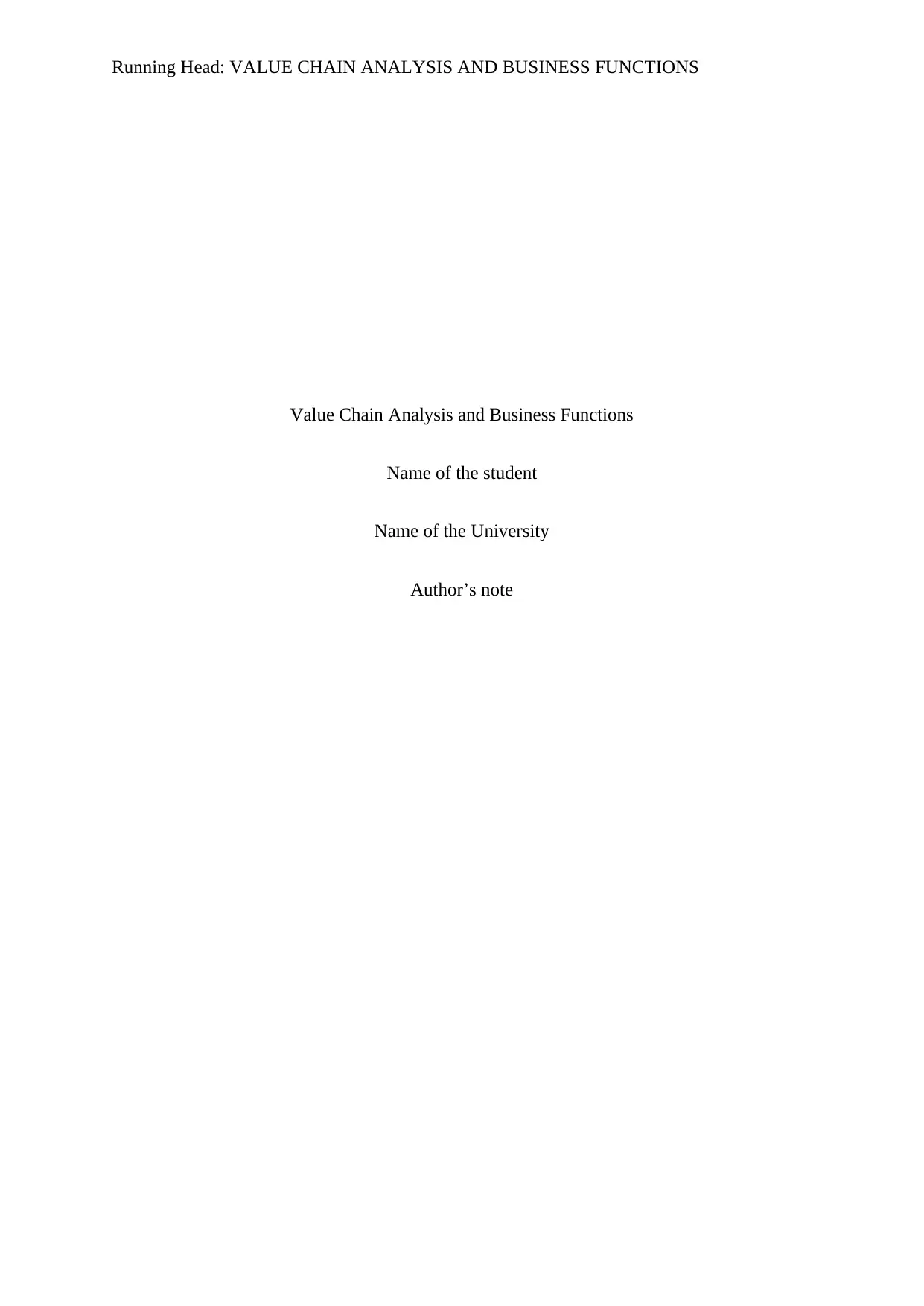
Running Head: VALUE CHAIN ANALYSIS AND BUSINESS FUNCTIONS
Value Chain Analysis and Business Functions
Name of the student
Name of the University
Author’s note
Value Chain Analysis and Business Functions
Name of the student
Name of the University
Author’s note
Paraphrase This Document
Need a fresh take? Get an instant paraphrase of this document with our AI Paraphraser
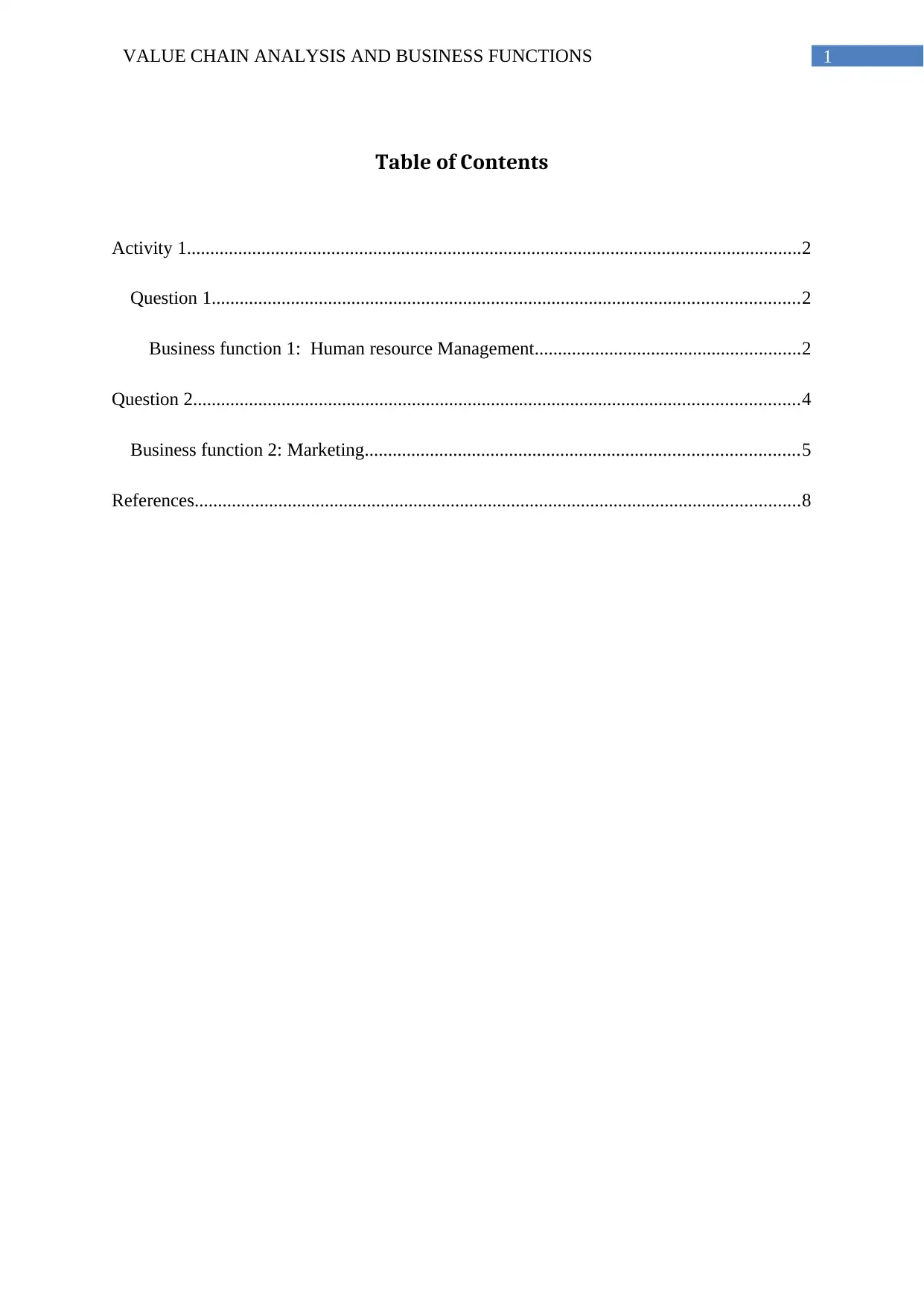
1VALUE CHAIN ANALYSIS AND BUSINESS FUNCTIONS
Table of Contents
Activity 1....................................................................................................................................2
Question 1..............................................................................................................................2
Business function 1: Human resource Management.........................................................2
Question 2..................................................................................................................................4
Business function 2: Marketing.............................................................................................5
References..................................................................................................................................8
Table of Contents
Activity 1....................................................................................................................................2
Question 1..............................................................................................................................2
Business function 1: Human resource Management.........................................................2
Question 2..................................................................................................................................4
Business function 2: Marketing.............................................................................................5
References..................................................................................................................................8
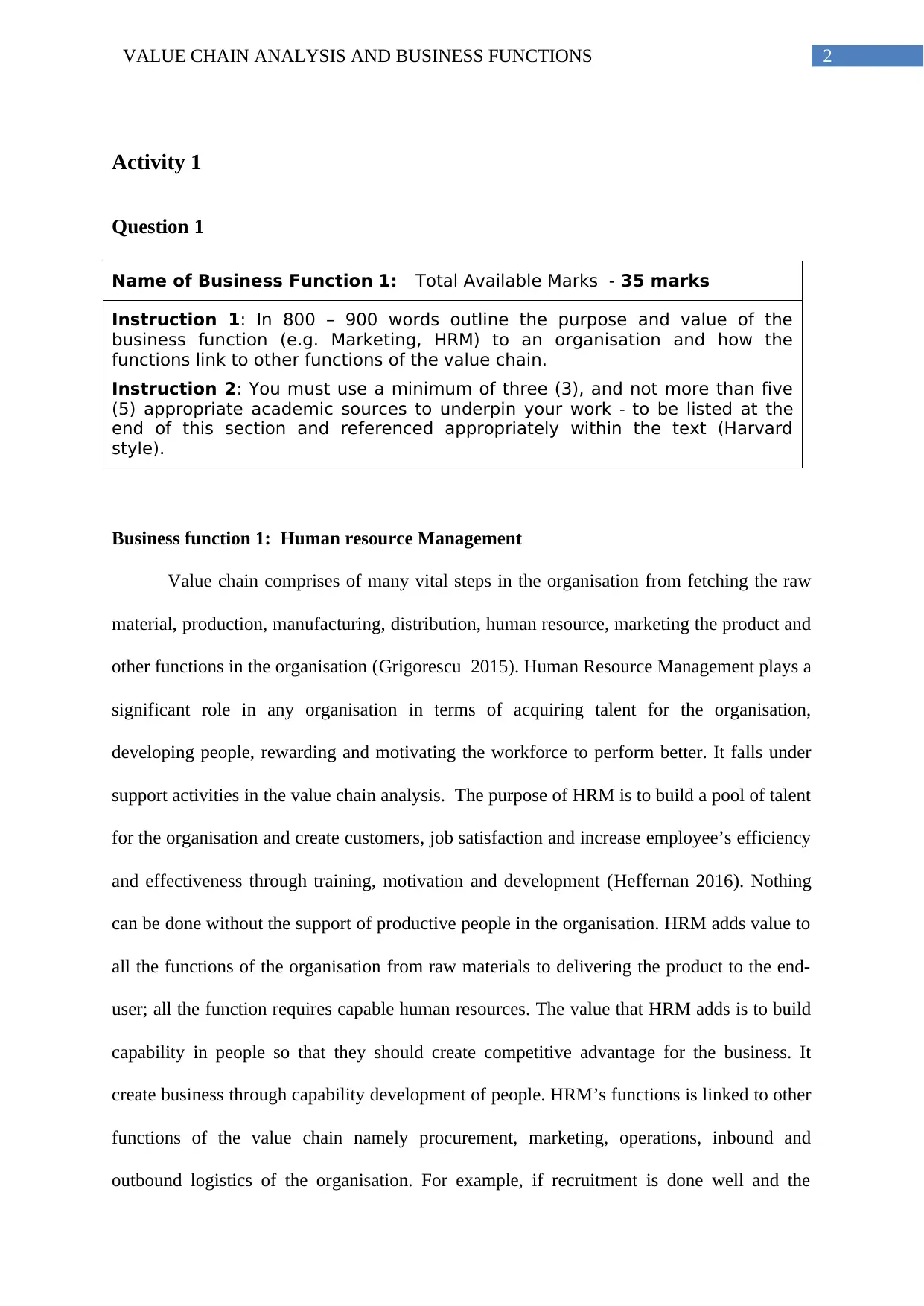
2VALUE CHAIN ANALYSIS AND BUSINESS FUNCTIONS
Activity 1
Question 1
Name of Business Function 1: Total Available Marks - 35 marks
Instruction 1: In 800 – 900 words outline the purpose and value of the
business function (e.g. Marketing, HRM) to an organisation and how the
functions link to other functions of the value chain.
Instruction 2: You must use a minimum of three (3), and not more than five
(5) appropriate academic sources to underpin your work - to be listed at the
end of this section and referenced appropriately within the text (Harvard
style).
Business function 1: Human resource Management
Value chain comprises of many vital steps in the organisation from fetching the raw
material, production, manufacturing, distribution, human resource, marketing the product and
other functions in the organisation (Grigorescu 2015). Human Resource Management plays a
significant role in any organisation in terms of acquiring talent for the organisation,
developing people, rewarding and motivating the workforce to perform better. It falls under
support activities in the value chain analysis. The purpose of HRM is to build a pool of talent
for the organisation and create customers, job satisfaction and increase employee’s efficiency
and effectiveness through training, motivation and development (Heffernan 2016). Nothing
can be done without the support of productive people in the organisation. HRM adds value to
all the functions of the organisation from raw materials to delivering the product to the end-
user; all the function requires capable human resources. The value that HRM adds is to build
capability in people so that they should create competitive advantage for the business. It
create business through capability development of people. HRM’s functions is linked to other
functions of the value chain namely procurement, marketing, operations, inbound and
outbound logistics of the organisation. For example, if recruitment is done well and the
Activity 1
Question 1
Name of Business Function 1: Total Available Marks - 35 marks
Instruction 1: In 800 – 900 words outline the purpose and value of the
business function (e.g. Marketing, HRM) to an organisation and how the
functions link to other functions of the value chain.
Instruction 2: You must use a minimum of three (3), and not more than five
(5) appropriate academic sources to underpin your work - to be listed at the
end of this section and referenced appropriately within the text (Harvard
style).
Business function 1: Human resource Management
Value chain comprises of many vital steps in the organisation from fetching the raw
material, production, manufacturing, distribution, human resource, marketing the product and
other functions in the organisation (Grigorescu 2015). Human Resource Management plays a
significant role in any organisation in terms of acquiring talent for the organisation,
developing people, rewarding and motivating the workforce to perform better. It falls under
support activities in the value chain analysis. The purpose of HRM is to build a pool of talent
for the organisation and create customers, job satisfaction and increase employee’s efficiency
and effectiveness through training, motivation and development (Heffernan 2016). Nothing
can be done without the support of productive people in the organisation. HRM adds value to
all the functions of the organisation from raw materials to delivering the product to the end-
user; all the function requires capable human resources. The value that HRM adds is to build
capability in people so that they should create competitive advantage for the business. It
create business through capability development of people. HRM’s functions is linked to other
functions of the value chain namely procurement, marketing, operations, inbound and
outbound logistics of the organisation. For example, if recruitment is done well and the
⊘ This is a preview!⊘
Do you want full access?
Subscribe today to unlock all pages.

Trusted by 1+ million students worldwide
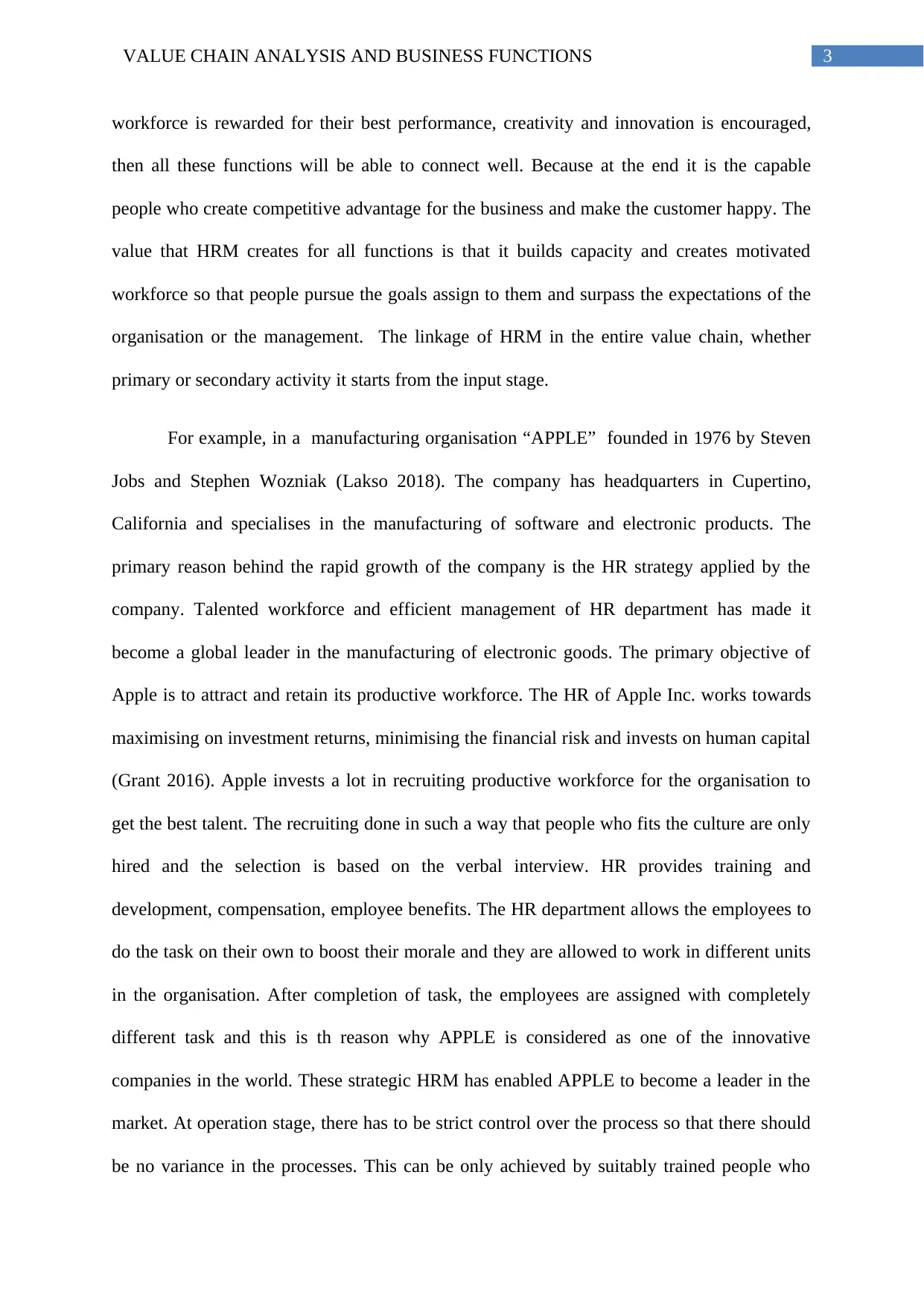
3VALUE CHAIN ANALYSIS AND BUSINESS FUNCTIONS
workforce is rewarded for their best performance, creativity and innovation is encouraged,
then all these functions will be able to connect well. Because at the end it is the capable
people who create competitive advantage for the business and make the customer happy. The
value that HRM creates for all functions is that it builds capacity and creates motivated
workforce so that people pursue the goals assign to them and surpass the expectations of the
organisation or the management. The linkage of HRM in the entire value chain, whether
primary or secondary activity it starts from the input stage.
For example, in a manufacturing organisation “APPLE” founded in 1976 by Steven
Jobs and Stephen Wozniak (Lakso 2018). The company has headquarters in Cupertino,
California and specialises in the manufacturing of software and electronic products. The
primary reason behind the rapid growth of the company is the HR strategy applied by the
company. Talented workforce and efficient management of HR department has made it
become a global leader in the manufacturing of electronic goods. The primary objective of
Apple is to attract and retain its productive workforce. The HR of Apple Inc. works towards
maximising on investment returns, minimising the financial risk and invests on human capital
(Grant 2016). Apple invests a lot in recruiting productive workforce for the organisation to
get the best talent. The recruiting done in such a way that people who fits the culture are only
hired and the selection is based on the verbal interview. HR provides training and
development, compensation, employee benefits. The HR department allows the employees to
do the task on their own to boost their morale and they are allowed to work in different units
in the organisation. After completion of task, the employees are assigned with completely
different task and this is th reason why APPLE is considered as one of the innovative
companies in the world. These strategic HRM has enabled APPLE to become a leader in the
market. At operation stage, there has to be strict control over the process so that there should
be no variance in the processes. This can be only achieved by suitably trained people who
workforce is rewarded for their best performance, creativity and innovation is encouraged,
then all these functions will be able to connect well. Because at the end it is the capable
people who create competitive advantage for the business and make the customer happy. The
value that HRM creates for all functions is that it builds capacity and creates motivated
workforce so that people pursue the goals assign to them and surpass the expectations of the
organisation or the management. The linkage of HRM in the entire value chain, whether
primary or secondary activity it starts from the input stage.
For example, in a manufacturing organisation “APPLE” founded in 1976 by Steven
Jobs and Stephen Wozniak (Lakso 2018). The company has headquarters in Cupertino,
California and specialises in the manufacturing of software and electronic products. The
primary reason behind the rapid growth of the company is the HR strategy applied by the
company. Talented workforce and efficient management of HR department has made it
become a global leader in the manufacturing of electronic goods. The primary objective of
Apple is to attract and retain its productive workforce. The HR of Apple Inc. works towards
maximising on investment returns, minimising the financial risk and invests on human capital
(Grant 2016). Apple invests a lot in recruiting productive workforce for the organisation to
get the best talent. The recruiting done in such a way that people who fits the culture are only
hired and the selection is based on the verbal interview. HR provides training and
development, compensation, employee benefits. The HR department allows the employees to
do the task on their own to boost their morale and they are allowed to work in different units
in the organisation. After completion of task, the employees are assigned with completely
different task and this is th reason why APPLE is considered as one of the innovative
companies in the world. These strategic HRM has enabled APPLE to become a leader in the
market. At operation stage, there has to be strict control over the process so that there should
be no variance in the processes. This can be only achieved by suitably trained people who
Paraphrase This Document
Need a fresh take? Get an instant paraphrase of this document with our AI Paraphraser
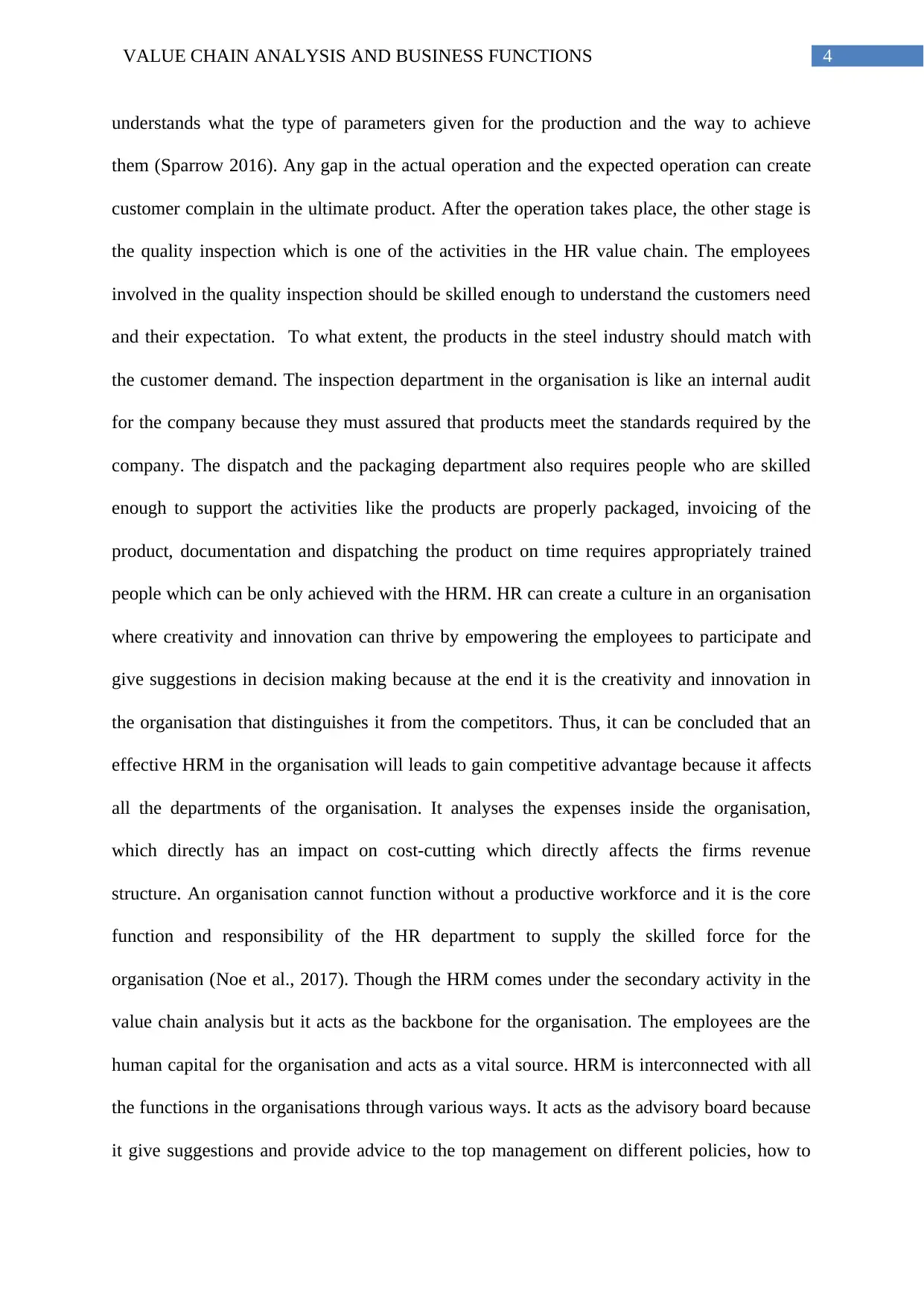
4VALUE CHAIN ANALYSIS AND BUSINESS FUNCTIONS
understands what the type of parameters given for the production and the way to achieve
them (Sparrow 2016). Any gap in the actual operation and the expected operation can create
customer complain in the ultimate product. After the operation takes place, the other stage is
the quality inspection which is one of the activities in the HR value chain. The employees
involved in the quality inspection should be skilled enough to understand the customers need
and their expectation. To what extent, the products in the steel industry should match with
the customer demand. The inspection department in the organisation is like an internal audit
for the company because they must assured that products meet the standards required by the
company. The dispatch and the packaging department also requires people who are skilled
enough to support the activities like the products are properly packaged, invoicing of the
product, documentation and dispatching the product on time requires appropriately trained
people which can be only achieved with the HRM. HR can create a culture in an organisation
where creativity and innovation can thrive by empowering the employees to participate and
give suggestions in decision making because at the end it is the creativity and innovation in
the organisation that distinguishes it from the competitors. Thus, it can be concluded that an
effective HRM in the organisation will leads to gain competitive advantage because it affects
all the departments of the organisation. It analyses the expenses inside the organisation,
which directly has an impact on cost-cutting which directly affects the firms revenue
structure. An organisation cannot function without a productive workforce and it is the core
function and responsibility of the HR department to supply the skilled force for the
organisation (Noe et al., 2017). Though the HRM comes under the secondary activity in the
value chain analysis but it acts as the backbone for the organisation. The employees are the
human capital for the organisation and acts as a vital source. HRM is interconnected with all
the functions in the organisations through various ways. It acts as the advisory board because
it give suggestions and provide advice to the top management on different policies, how to
understands what the type of parameters given for the production and the way to achieve
them (Sparrow 2016). Any gap in the actual operation and the expected operation can create
customer complain in the ultimate product. After the operation takes place, the other stage is
the quality inspection which is one of the activities in the HR value chain. The employees
involved in the quality inspection should be skilled enough to understand the customers need
and their expectation. To what extent, the products in the steel industry should match with
the customer demand. The inspection department in the organisation is like an internal audit
for the company because they must assured that products meet the standards required by the
company. The dispatch and the packaging department also requires people who are skilled
enough to support the activities like the products are properly packaged, invoicing of the
product, documentation and dispatching the product on time requires appropriately trained
people which can be only achieved with the HRM. HR can create a culture in an organisation
where creativity and innovation can thrive by empowering the employees to participate and
give suggestions in decision making because at the end it is the creativity and innovation in
the organisation that distinguishes it from the competitors. Thus, it can be concluded that an
effective HRM in the organisation will leads to gain competitive advantage because it affects
all the departments of the organisation. It analyses the expenses inside the organisation,
which directly has an impact on cost-cutting which directly affects the firms revenue
structure. An organisation cannot function without a productive workforce and it is the core
function and responsibility of the HR department to supply the skilled force for the
organisation (Noe et al., 2017). Though the HRM comes under the secondary activity in the
value chain analysis but it acts as the backbone for the organisation. The employees are the
human capital for the organisation and acts as a vital source. HRM is interconnected with all
the functions in the organisations through various ways. It acts as the advisory board because
it give suggestions and provide advice to the top management on different policies, how to
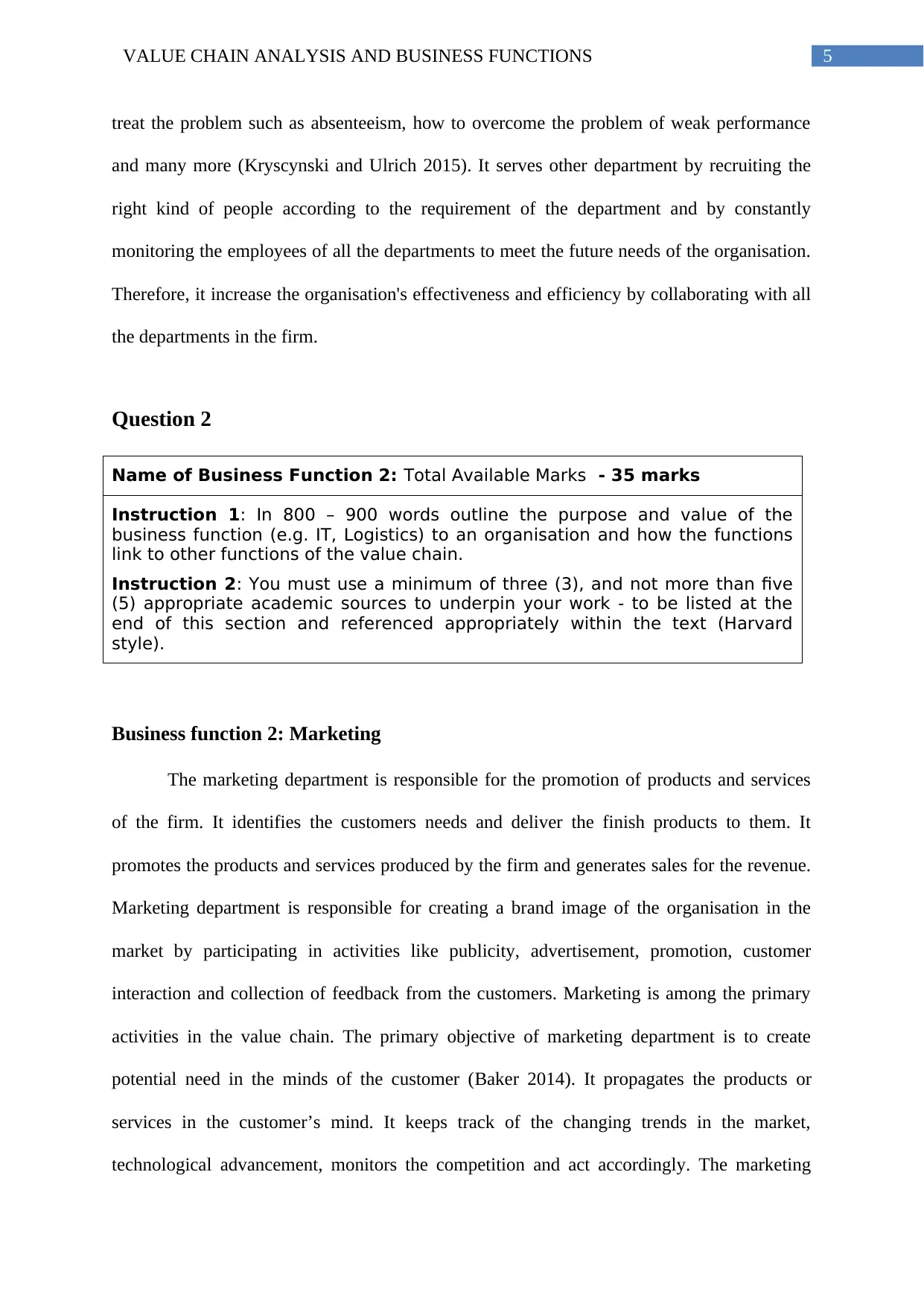
5VALUE CHAIN ANALYSIS AND BUSINESS FUNCTIONS
treat the problem such as absenteeism, how to overcome the problem of weak performance
and many more (Kryscynski and Ulrich 2015). It serves other department by recruiting the
right kind of people according to the requirement of the department and by constantly
monitoring the employees of all the departments to meet the future needs of the organisation.
Therefore, it increase the organisation's effectiveness and efficiency by collaborating with all
the departments in the firm.
Question 2
Name of Business Function 2: Total Available Marks - 35 marks
Instruction 1: In 800 – 900 words outline the purpose and value of the
business function (e.g. IT, Logistics) to an organisation and how the functions
link to other functions of the value chain.
Instruction 2: You must use a minimum of three (3), and not more than five
(5) appropriate academic sources to underpin your work - to be listed at the
end of this section and referenced appropriately within the text (Harvard
style).
Business function 2: Marketing
The marketing department is responsible for the promotion of products and services
of the firm. It identifies the customers needs and deliver the finish products to them. It
promotes the products and services produced by the firm and generates sales for the revenue.
Marketing department is responsible for creating a brand image of the organisation in the
market by participating in activities like publicity, advertisement, promotion, customer
interaction and collection of feedback from the customers. Marketing is among the primary
activities in the value chain. The primary objective of marketing department is to create
potential need in the minds of the customer (Baker 2014). It propagates the products or
services in the customer’s mind. It keeps track of the changing trends in the market,
technological advancement, monitors the competition and act accordingly. The marketing
treat the problem such as absenteeism, how to overcome the problem of weak performance
and many more (Kryscynski and Ulrich 2015). It serves other department by recruiting the
right kind of people according to the requirement of the department and by constantly
monitoring the employees of all the departments to meet the future needs of the organisation.
Therefore, it increase the organisation's effectiveness and efficiency by collaborating with all
the departments in the firm.
Question 2
Name of Business Function 2: Total Available Marks - 35 marks
Instruction 1: In 800 – 900 words outline the purpose and value of the
business function (e.g. IT, Logistics) to an organisation and how the functions
link to other functions of the value chain.
Instruction 2: You must use a minimum of three (3), and not more than five
(5) appropriate academic sources to underpin your work - to be listed at the
end of this section and referenced appropriately within the text (Harvard
style).
Business function 2: Marketing
The marketing department is responsible for the promotion of products and services
of the firm. It identifies the customers needs and deliver the finish products to them. It
promotes the products and services produced by the firm and generates sales for the revenue.
Marketing department is responsible for creating a brand image of the organisation in the
market by participating in activities like publicity, advertisement, promotion, customer
interaction and collection of feedback from the customers. Marketing is among the primary
activities in the value chain. The primary objective of marketing department is to create
potential need in the minds of the customer (Baker 2014). It propagates the products or
services in the customer’s mind. It keeps track of the changing trends in the market,
technological advancement, monitors the competition and act accordingly. The marketing
⊘ This is a preview!⊘
Do you want full access?
Subscribe today to unlock all pages.

Trusted by 1+ million students worldwide
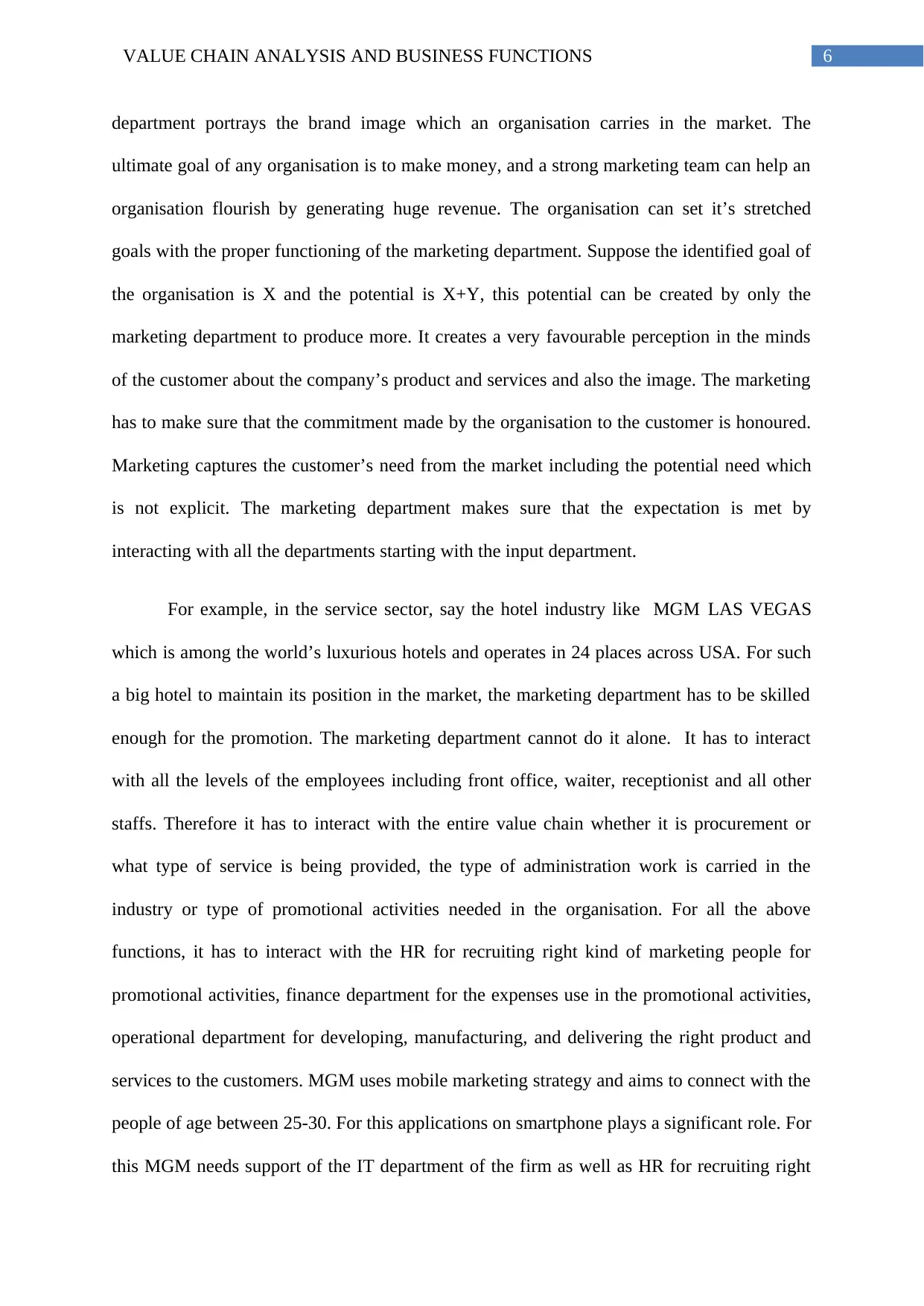
6VALUE CHAIN ANALYSIS AND BUSINESS FUNCTIONS
department portrays the brand image which an organisation carries in the market. The
ultimate goal of any organisation is to make money, and a strong marketing team can help an
organisation flourish by generating huge revenue. The organisation can set it’s stretched
goals with the proper functioning of the marketing department. Suppose the identified goal of
the organisation is X and the potential is X+Y, this potential can be created by only the
marketing department to produce more. It creates a very favourable perception in the minds
of the customer about the company’s product and services and also the image. The marketing
has to make sure that the commitment made by the organisation to the customer is honoured.
Marketing captures the customer’s need from the market including the potential need which
is not explicit. The marketing department makes sure that the expectation is met by
interacting with all the departments starting with the input department.
For example, in the service sector, say the hotel industry like MGM LAS VEGAS
which is among the world’s luxurious hotels and operates in 24 places across USA. For such
a big hotel to maintain its position in the market, the marketing department has to be skilled
enough for the promotion. The marketing department cannot do it alone. It has to interact
with all the levels of the employees including front office, waiter, receptionist and all other
staffs. Therefore it has to interact with the entire value chain whether it is procurement or
what type of service is being provided, the type of administration work is carried in the
industry or type of promotional activities needed in the organisation. For all the above
functions, it has to interact with the HR for recruiting right kind of marketing people for
promotional activities, finance department for the expenses use in the promotional activities,
operational department for developing, manufacturing, and delivering the right product and
services to the customers. MGM uses mobile marketing strategy and aims to connect with the
people of age between 25-30. For this applications on smartphone plays a significant role. For
this MGM needs support of the IT department of the firm as well as HR for recruiting right
department portrays the brand image which an organisation carries in the market. The
ultimate goal of any organisation is to make money, and a strong marketing team can help an
organisation flourish by generating huge revenue. The organisation can set it’s stretched
goals with the proper functioning of the marketing department. Suppose the identified goal of
the organisation is X and the potential is X+Y, this potential can be created by only the
marketing department to produce more. It creates a very favourable perception in the minds
of the customer about the company’s product and services and also the image. The marketing
has to make sure that the commitment made by the organisation to the customer is honoured.
Marketing captures the customer’s need from the market including the potential need which
is not explicit. The marketing department makes sure that the expectation is met by
interacting with all the departments starting with the input department.
For example, in the service sector, say the hotel industry like MGM LAS VEGAS
which is among the world’s luxurious hotels and operates in 24 places across USA. For such
a big hotel to maintain its position in the market, the marketing department has to be skilled
enough for the promotion. The marketing department cannot do it alone. It has to interact
with all the levels of the employees including front office, waiter, receptionist and all other
staffs. Therefore it has to interact with the entire value chain whether it is procurement or
what type of service is being provided, the type of administration work is carried in the
industry or type of promotional activities needed in the organisation. For all the above
functions, it has to interact with the HR for recruiting right kind of marketing people for
promotional activities, finance department for the expenses use in the promotional activities,
operational department for developing, manufacturing, and delivering the right product and
services to the customers. MGM uses mobile marketing strategy and aims to connect with the
people of age between 25-30. For this applications on smartphone plays a significant role. For
this MGM needs support of the IT department of the firm as well as HR for recruiting right
Paraphrase This Document
Need a fresh take? Get an instant paraphrase of this document with our AI Paraphraser
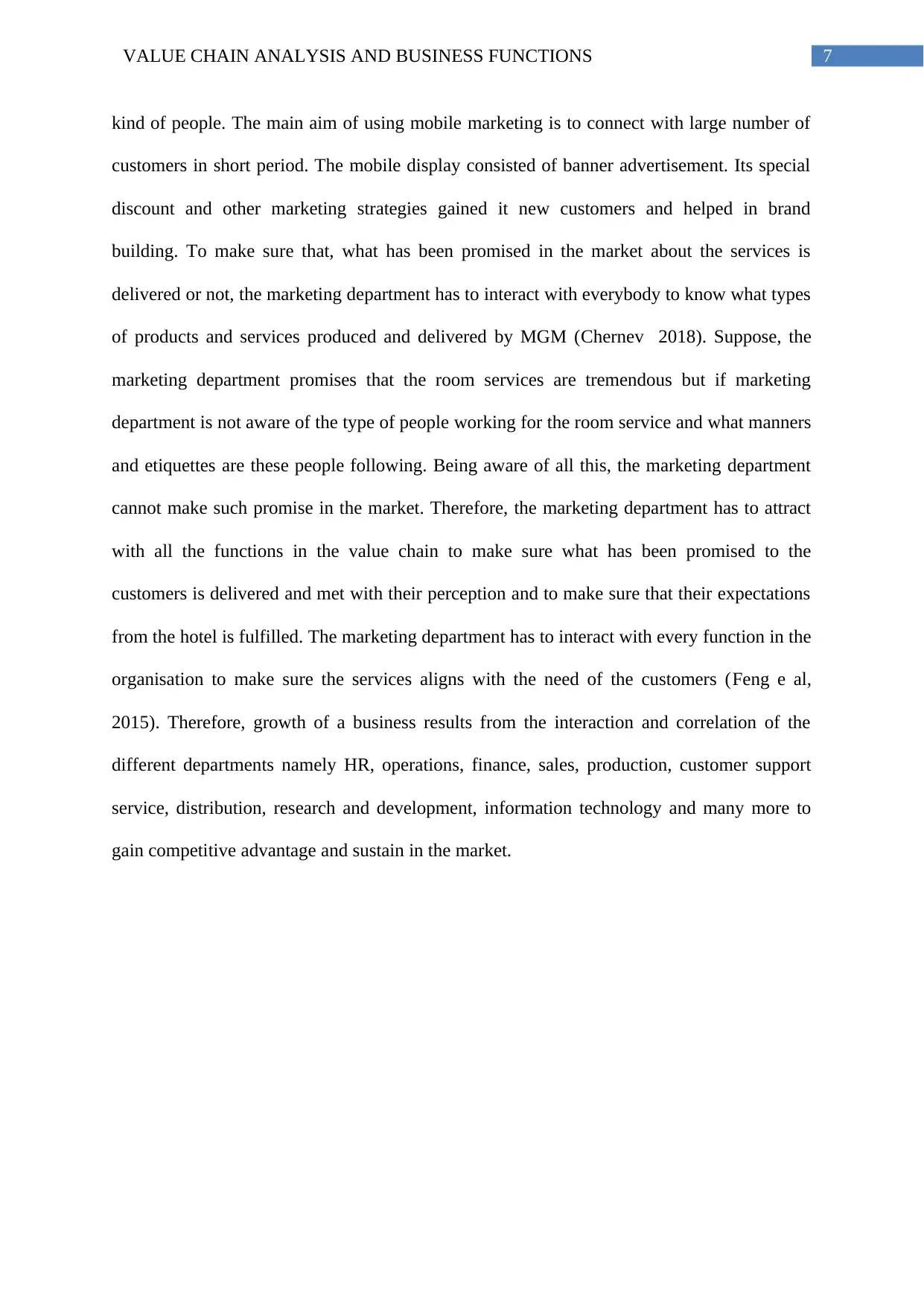
7VALUE CHAIN ANALYSIS AND BUSINESS FUNCTIONS
kind of people. The main aim of using mobile marketing is to connect with large number of
customers in short period. The mobile display consisted of banner advertisement. Its special
discount and other marketing strategies gained it new customers and helped in brand
building. To make sure that, what has been promised in the market about the services is
delivered or not, the marketing department has to interact with everybody to know what types
of products and services produced and delivered by MGM (Chernev 2018). Suppose, the
marketing department promises that the room services are tremendous but if marketing
department is not aware of the type of people working for the room service and what manners
and etiquettes are these people following. Being aware of all this, the marketing department
cannot make such promise in the market. Therefore, the marketing department has to attract
with all the functions in the value chain to make sure what has been promised to the
customers is delivered and met with their perception and to make sure that their expectations
from the hotel is fulfilled. The marketing department has to interact with every function in the
organisation to make sure the services aligns with the need of the customers (Feng e al,
2015). Therefore, growth of a business results from the interaction and correlation of the
different departments namely HR, operations, finance, sales, production, customer support
service, distribution, research and development, information technology and many more to
gain competitive advantage and sustain in the market.
kind of people. The main aim of using mobile marketing is to connect with large number of
customers in short period. The mobile display consisted of banner advertisement. Its special
discount and other marketing strategies gained it new customers and helped in brand
building. To make sure that, what has been promised in the market about the services is
delivered or not, the marketing department has to interact with everybody to know what types
of products and services produced and delivered by MGM (Chernev 2018). Suppose, the
marketing department promises that the room services are tremendous but if marketing
department is not aware of the type of people working for the room service and what manners
and etiquettes are these people following. Being aware of all this, the marketing department
cannot make such promise in the market. Therefore, the marketing department has to attract
with all the functions in the value chain to make sure what has been promised to the
customers is delivered and met with their perception and to make sure that their expectations
from the hotel is fulfilled. The marketing department has to interact with every function in the
organisation to make sure the services aligns with the need of the customers (Feng e al,
2015). Therefore, growth of a business results from the interaction and correlation of the
different departments namely HR, operations, finance, sales, production, customer support
service, distribution, research and development, information technology and many more to
gain competitive advantage and sustain in the market.
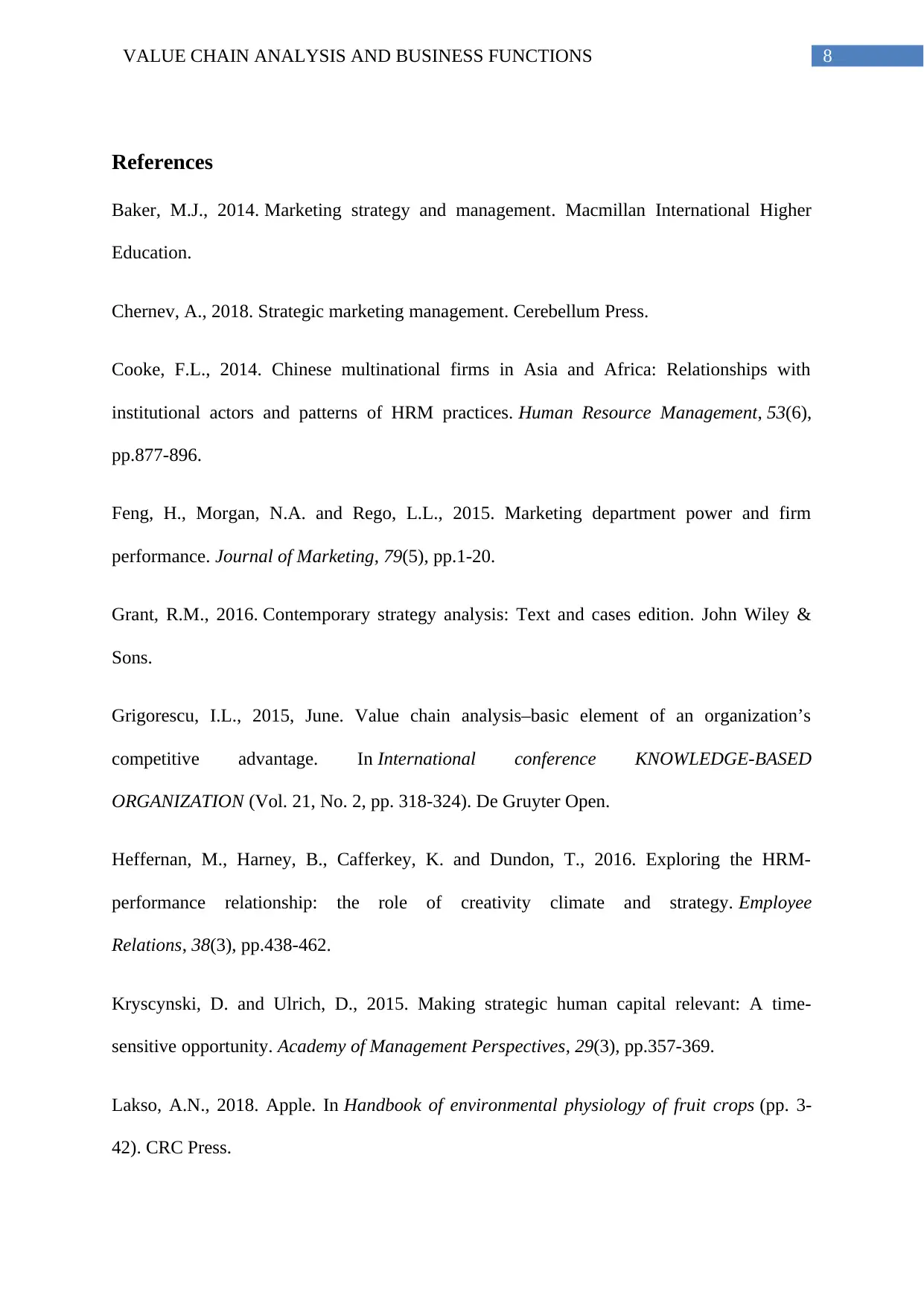
8VALUE CHAIN ANALYSIS AND BUSINESS FUNCTIONS
References
Baker, M.J., 2014. Marketing strategy and management. Macmillan International Higher
Education.
Chernev, A., 2018. Strategic marketing management. Cerebellum Press.
Cooke, F.L., 2014. Chinese multinational firms in Asia and Africa: Relationships with
institutional actors and patterns of HRM practices. Human Resource Management, 53(6),
pp.877-896.
Feng, H., Morgan, N.A. and Rego, L.L., 2015. Marketing department power and firm
performance. Journal of Marketing, 79(5), pp.1-20.
Grant, R.M., 2016. Contemporary strategy analysis: Text and cases edition. John Wiley &
Sons.
Grigorescu, I.L., 2015, June. Value chain analysis–basic element of an organization’s
competitive advantage. In International conference KNOWLEDGE-BASED
ORGANIZATION (Vol. 21, No. 2, pp. 318-324). De Gruyter Open.
Heffernan, M., Harney, B., Cafferkey, K. and Dundon, T., 2016. Exploring the HRM-
performance relationship: the role of creativity climate and strategy. Employee
Relations, 38(3), pp.438-462.
Kryscynski, D. and Ulrich, D., 2015. Making strategic human capital relevant: A time-
sensitive opportunity. Academy of Management Perspectives, 29(3), pp.357-369.
Lakso, A.N., 2018. Apple. In Handbook of environmental physiology of fruit crops (pp. 3-
42). CRC Press.
References
Baker, M.J., 2014. Marketing strategy and management. Macmillan International Higher
Education.
Chernev, A., 2018. Strategic marketing management. Cerebellum Press.
Cooke, F.L., 2014. Chinese multinational firms in Asia and Africa: Relationships with
institutional actors and patterns of HRM practices. Human Resource Management, 53(6),
pp.877-896.
Feng, H., Morgan, N.A. and Rego, L.L., 2015. Marketing department power and firm
performance. Journal of Marketing, 79(5), pp.1-20.
Grant, R.M., 2016. Contemporary strategy analysis: Text and cases edition. John Wiley &
Sons.
Grigorescu, I.L., 2015, June. Value chain analysis–basic element of an organization’s
competitive advantage. In International conference KNOWLEDGE-BASED
ORGANIZATION (Vol. 21, No. 2, pp. 318-324). De Gruyter Open.
Heffernan, M., Harney, B., Cafferkey, K. and Dundon, T., 2016. Exploring the HRM-
performance relationship: the role of creativity climate and strategy. Employee
Relations, 38(3), pp.438-462.
Kryscynski, D. and Ulrich, D., 2015. Making strategic human capital relevant: A time-
sensitive opportunity. Academy of Management Perspectives, 29(3), pp.357-369.
Lakso, A.N., 2018. Apple. In Handbook of environmental physiology of fruit crops (pp. 3-
42). CRC Press.
⊘ This is a preview!⊘
Do you want full access?
Subscribe today to unlock all pages.

Trusted by 1+ million students worldwide
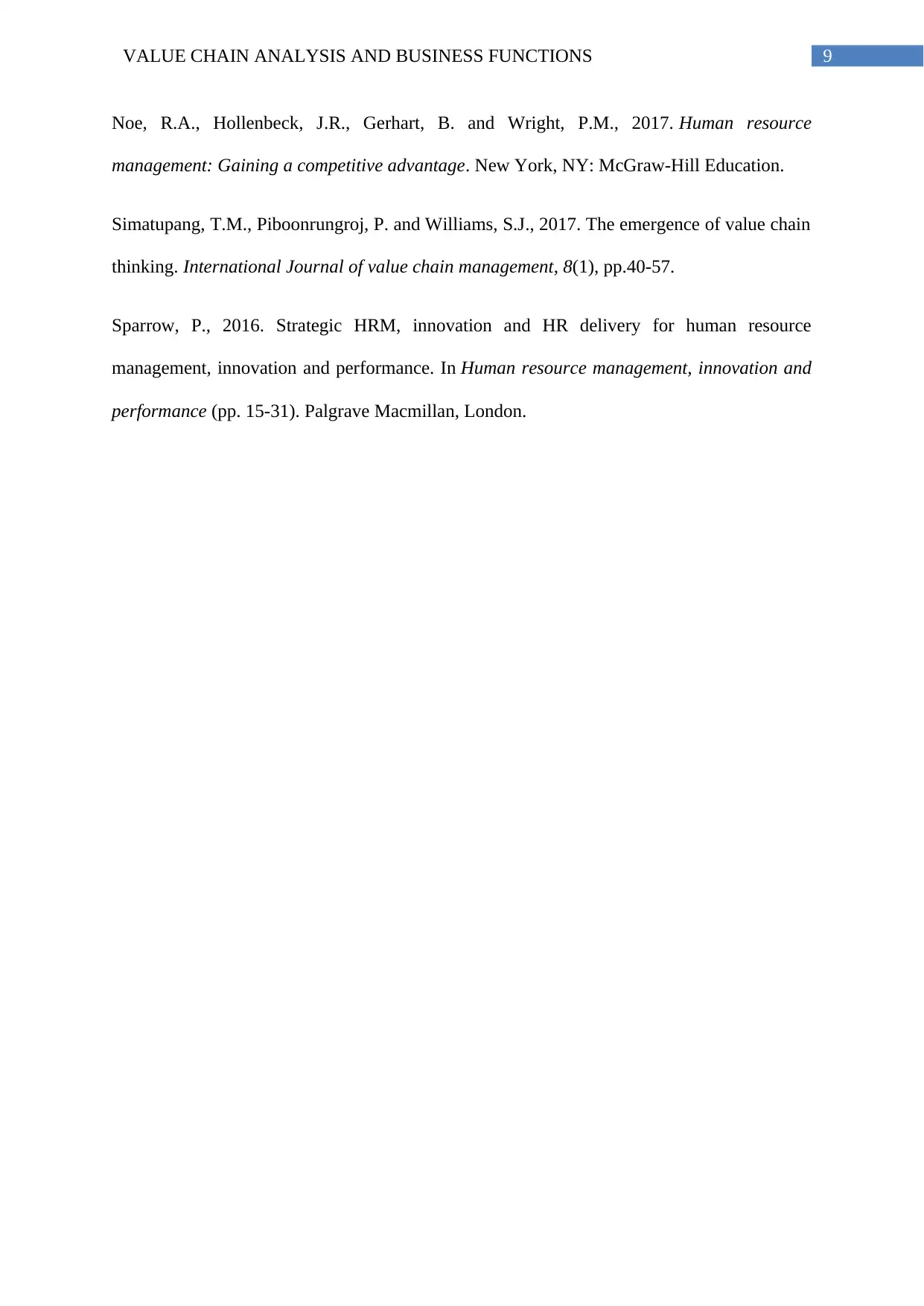
9VALUE CHAIN ANALYSIS AND BUSINESS FUNCTIONS
Noe, R.A., Hollenbeck, J.R., Gerhart, B. and Wright, P.M., 2017. Human resource
management: Gaining a competitive advantage. New York, NY: McGraw-Hill Education.
Simatupang, T.M., Piboonrungroj, P. and Williams, S.J., 2017. The emergence of value chain
thinking. International Journal of value chain management, 8(1), pp.40-57.
Sparrow, P., 2016. Strategic HRM, innovation and HR delivery for human resource
management, innovation and performance. In Human resource management, innovation and
performance (pp. 15-31). Palgrave Macmillan, London.
Noe, R.A., Hollenbeck, J.R., Gerhart, B. and Wright, P.M., 2017. Human resource
management: Gaining a competitive advantage. New York, NY: McGraw-Hill Education.
Simatupang, T.M., Piboonrungroj, P. and Williams, S.J., 2017. The emergence of value chain
thinking. International Journal of value chain management, 8(1), pp.40-57.
Sparrow, P., 2016. Strategic HRM, innovation and HR delivery for human resource
management, innovation and performance. In Human resource management, innovation and
performance (pp. 15-31). Palgrave Macmillan, London.
Paraphrase This Document
Need a fresh take? Get an instant paraphrase of this document with our AI Paraphraser

10VALUE CHAIN ANALYSIS AND BUSINESS FUNCTIONS
1 out of 11
Related Documents
Your All-in-One AI-Powered Toolkit for Academic Success.
+13062052269
info@desklib.com
Available 24*7 on WhatsApp / Email
![[object Object]](/_next/static/media/star-bottom.7253800d.svg)
Unlock your academic potential
Copyright © 2020–2025 A2Z Services. All Rights Reserved. Developed and managed by ZUCOL.



